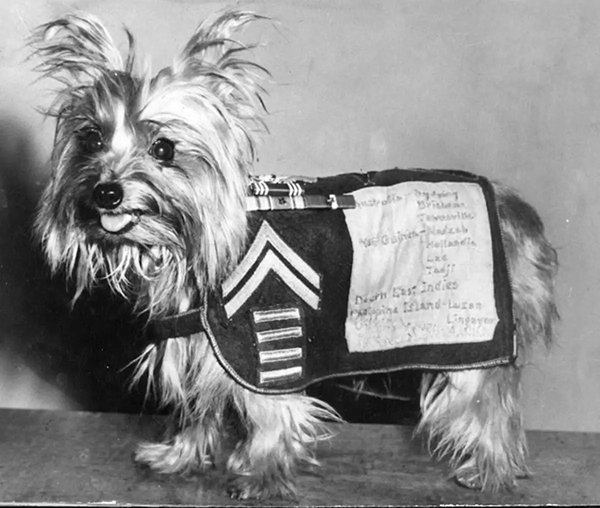“Bow-wow, bow-wow, arf-arf, woof!” That’s dog-speak for National K-9 Veterans Day, celebrated on March 13 and commemorating the service and sacrifices of American military dogs throughout history.��
The United States had an unofficial canine force in World War I. Military dogs, however, were not officially recognized until��March 13, 1942, when a private organization, Dogs for Defense, was established to recruit the public’s dogs for the U.S. military’s War Dog Program. Thus, the K-9 Corps was born. Often referred to as the “unsung heroes of the battlefield,” war dogs stand beside their handlers facing danger and providing protection for thousands of men and women in combat.
In recognition of National K-9 Veterans Day, the following three stories of dogs from different conflicts exemplify the honor and courage of our country’s military working dogs.
Stubby: WWI Hero Promoted to Sergeant
While training in New Haven, CT, soldiers befriended a mixed breed dog who seemed to enjoy their company. They named him Stubby. Smuggled to Europe by his new friends, Stubby became the unofficial mascot of the 102nd Infantry Regiment, assigned to the 26th Yankee Division.
In France the fearless pup participated in 17 battles and four offensives on the Western Front. Stubby’s patriotic contributions included alerting troops to incoming mustard gas attacks, comforting the wounded, locating missing soldiers lost between the trenches, and boosting morale. Stubby allegedly caught a German soldier by the seat of his pants, holding him until American soldiers assumed responsibility.
General John “Black Jack” Pershing, Commander of the American Expeditionary Forces, presented America’s four-legged hero with a gold medal, praising his “heroism of the highest caliber” and “bravery under fire.” Stubby is the first dog to be nominated and promoted to sergeant through combat. His remains lie in the Smithsonian Institution.

Stubby was promoted to Sergeant in WWI and received a gold medal from General John Pershing.
Smoky: WWII’s Smallest Soldier
Slogging through a dense New Guinea jungle during WWII, an American GI heard a puppy yapping and discovered a 4-pound 17” tall Yorkshire Terrier in an abandoned foxhole. Smoky was adopted by Corporal William Wynne and the inseparable duo spent the next two years braving a kamikaze attack, heat, limited rations, typhoons, air raids, combat missions and parachute jumps. Smoky had her own homemade parachute.
Smoky’s most famous exploit occurred in January 1945 on a Japanese island when, encouraged and directed by Wynne, she crawled through a narrow sand-filled 70-foot-long 8-inch-wide culvert with a telephone cable attached to her collar.�� Her courage spared GIs from exposure to enemy bombs and bullets.
When the war ended Wynne smuggled the tiny dog back to the U.S. in an oxygen mask carrying case. Dubbed “Yorkie Doodle Dandy,” Smoky became a celebrity as well as��the world’s first therapy dog, visiting wounded veterans in hospitals across the nation.

At 17″ tall, Smoky was small in stature, but large on courage and heart.
WWII’s smallest soldier, Smoky had her own parachute.

Nemo: Wounded in Action in Vietnam
During the Vietnam War, German Shepherd Dog Nemo and his partner, Airman 2nd Class Robert Thorneburg served as a sentry dog team in the 377th Air Police Squadron at Tan Son Nhut Air Base, Saigon.
On December 3, 1966, two VC units tried to infiltrate the base. Thorneburg and Nemo were on sentry duty at an old Vietnamese graveyard near the air base’s runways. Nemo detected several VCs making an assault and sounded the alert. Thorneburg was shot in the shoulder and Nemo was shot in the muzzle, the bullet exiting through his right eye.
Ignoring his serious head wound, the 85-pound shepherd attacked the four Vietcong guerillas, giving Thorneburg time to call in backup to secure the attack. Only then were man and man’s best friend medevacked to safety. The base veterinarian performed surgery, but Nemo lost his right eye. In July 1967, he returned to the states as the first sentry dog officially retired from active service.
Credited with saving Thorneburg’s life, Nemo was hailed as a hero. He was taken on tours throughout the U.S. and lived in a special kennel at Lackland Air Force Base in Texas until his death in 1972.
In Vietnam, military dogs were credited with saving the lives of 10,000 men, although many handlers who served there feel this number is grossly underestimated. Of approximately 87,000 missions, the dogs uncovered 2,000 tunnels and bunkers and enabled 1,000 enemy captures and 4,000 enemy kills. (From “WAR DOGS: Tales of Canine Heroism, History, and Love” by Rebecca Frankel.)
Sadly, Nemo was one of only 200 of the 4,000��dogs who served in the Vietnam War who returned home after the war ended.��Their handlers and other veterans continued to fight for the rights of war dogs, pushing for legislation to create a program��for their adoption. As a result, Congress passed “Robby’s Law,” signed by President Clinton in 2000, ensuring that dogs now serving in the U.S. military will have a home when they finish their service.

Nemo lost an eye during the Vietnam War, which did not deter the courageous attack which saved his handler. He was retired to Lackland, AFB, in Texas and made numerous national tours.

Service dog Ranger poses with his handler, Johnny Martinez, and members of the Transylvania County Honor Guard during a ceremony in Brevard.

Today’s military working dogs will return home, thanks to “Robby’s Law,” passed in 2000. No dogs left behind.
Providing safety and rescue for our men and women on the battlefield and offering indispensable services and succor to veterans in need of support at home, canines inspire and remind us of the unbreakable bond between humans and their dogs.
To all canine veterans, past and present, for your courage, intelligence, and loyalty: Thank you for your service!


Thanks be to God💖
For all K-9 🐾
The dogs of War🐾
The courage, love, loyalty of military working Dogs🐾